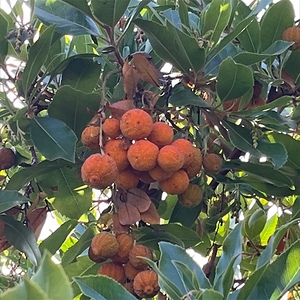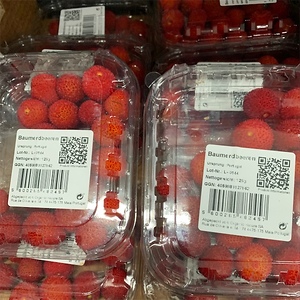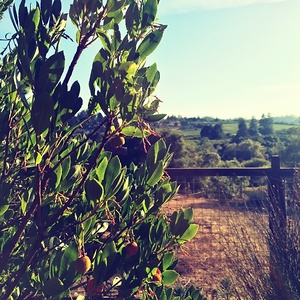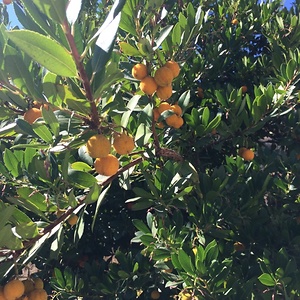

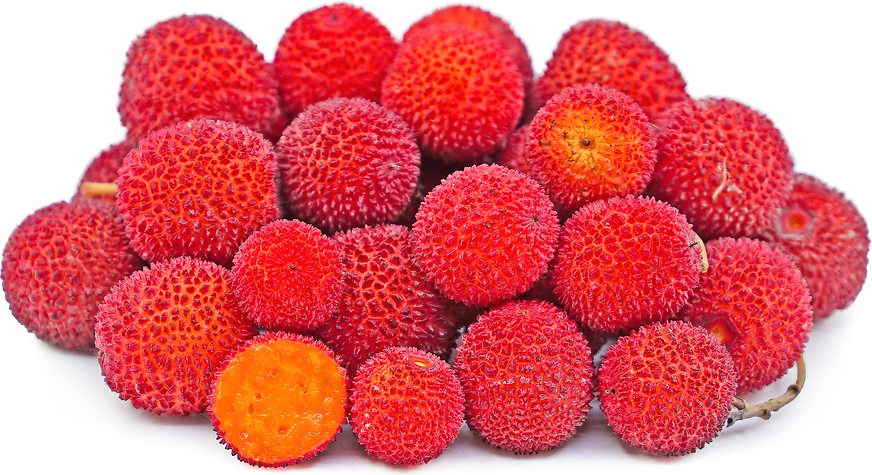
Strawberry Tree
Estimated Inventory, lb : 0
Description/Taste
Strawberry tree fruits are small, averaging 1 to 3 centimeters in diameter, and have a round to oval shape. The fruit’s delicate and thin skin has a textured, bumpy, and rough surface, covered in soft and tiny, bristle-like protrusions. When young, the fruits are yellow, and as they slowly ripen, they transform into a bright red hue. Underneath the surface, the fruit’s flesh is soft and golden-orange, encasing many small seeds giving the flesh a gritty, sandy, and mealy consistency. Strawberry tree fruits emit a faint aroma reminiscent of anise and have a subtly fruity, sweet-tart, and woody flavor with mango, apricot, guava, and peach nuances. The fruits are not commonly consumed fresh due to their gritty texture and muted flavor, but they are incorporated into sauces, jams, and jellies. In addition to the fruits, Strawberry trees are known for their fragrant white to pale pink flowers and serrated-edged, evergreen leaves.
Seasons/Availability
Strawberry trees bloom in the fall through winter, and the fruits ripen in the late summer through winter.
Current Facts
Strawberry trees, botanically classified as Arbutus unedo, are evergreen shrubs or small trees belonging to the Ericaceae family. The plants reach anywhere from 5 to 10 meters in height and are easy to cultivate, being shade, drought, and frost tolerant. Strawberry trees are primarily ornamental, favored for their textured, multicolored bark, evergreen leaves, and aromatic flowers. The trees are also known for their brightly colored edible fruits. Despite the fruit’s unique, textured appearance and strawberry moniker, Strawberry tree fruits have a mild flavor and are mainly incorporated into cooked preparations with added sweetener or other flavor enhancers. Strawberry tree fruits are also known as Cane or Cain apple, Irish Strawberry tree, Andrachne, and the Killarney Strawberry tree. The fruits are delicate and highly perishable, rarely cultivated for commercial production, and the trees are variable in fruit production, dependent on the climate. Strawberry tree fruits take approximately twelve months to mature and are foraged from wild and home garden trees, sold through local markets and distributors as a specialty fruit.
Nutritional Value
Strawberry tree fruits are an excellent source of fiber to regulate the digestive tracts and vitamin C to strengthen the immune system. The fruits also contain beta-carotene, colored pigments in the flesh that provide antioxidant-like properties to reduce inflammation. In natural medicines, Strawberry tree fruits have been incorporated into decoctions as a diuretic, tonic, or antiseptic.
Applications
Strawberry tree fruits have a bland, sweet, and subtly fruity flavor and a sandy, gritty texture. The fruits are not commonly consumed fresh due to their lackluster taste and texture, but they can occasionally be combined into green salads or blended into smoothies with other fruits. Strawberry tree fruits are more traditionally cooked with sugar or other flavorful fruits to create jams or marmalades. These jams are spread over biscuits, toast, and buns or made into a sweet filling for cakes, pies, and tarts. Strawberry tree fruits can also be cooked into syrups and glazes for ice creams, gelatos, granitas, and sorbets. In addition to sauces, syrups, and culinary dishes, Strawberry tree fruits are popularly fermented into cocktails, spirits, and mocktails. In Albania, the fruits are infused into rakija, a traditional distilled drink offered to houseguests. The fruits are also sieved and cooked with citrus and sugar to make honey, a commodity famous in Sardinia. Strawberry tree fruit honey is known as miele amaro in Sardinia and has a bittersweet flavor, utilized for pastries, beverages, desserts, and teas. Strawberry tree fruits pair well with fruits such as oranges, limes, lemons, grapefruit, and watermelon, lavender, mint, vanilla, ginger, brown sugar, and cheeses, including pecorino, feta, ricotta, chevre, and blue. The fruits are highly perishable, easily bruised, punctured, or smashed, and are foraged from trees for sale in local markets. Strawberry tree fruits should be immediately consumed or cooked for the best quality or flavor.
Ethnic/Cultural Info
In Portugal, Strawberry tree fruits are traditionally fermented into a spirit known as Aguardente de Medronho. Strawberry tree fruits grow wild throughout Portugal, especially in Algarve and Lousa, and are seasonally harvested from October through December. For hundreds of years, Strawberry tree fruits have been collected, fermented, and distilled into a fruit brandy, consumed in small quantities as a meal accompaniment and as a shot to warm the body. The clear, strong spirit bears a slightly musky flavor, and each batch of brandy will taste slightly different depending on the way it was processed and the maker. Aguardente de Medronho is customarily developed through private, small-batch producers and many Portuguese households take pride in their family recipe. The beverage is also known as “firewater” due to a rough translation and the burning sensation created in the throat when consuming the spirit. In the modern-day, many farmers still distill the spirit annually, and a few commercial companies have begun processing the brandy. Aguardente de Medronho is a traditional drink of Portugal, and the unique beverage is primarily sold directly to the consumer from the local distillers.
Geography/History
Strawberry trees are native to temperate regions of Asia and Europe and have been growing wild since ancient times. The trees thrive in various soils, spanning across the Mediterranean, Portugal, France, and Spain, North Africa, and east into Turkey and Syria. The fruiting branches of the trees were a symbol of good luck in Ancient Rome, and throughout history, the Strawberry tree has appeared in paintings, poems, songs, and literature. Strawberry trees were also introduced in the Early Ages into Ireland and were sent to England in the 16th century. In 1753, the species was named and mentioned in Species Plantarum, a famous scientific work written by Carl Linnaeus. The species was also brought to the United States and planted in Thomas Jefferson’s Monticello Garden in the 18th century. Today Strawberry trees are planted throughout Europe and Western Asia and are found growing wild and in home gardens. The trees are also cultivated in home gardens and planted along city streets in the Pacific Northwest and Northern California.
Recipe Ideas
Recipes that include Strawberry Tree. One
| Gather Victoria |
|
Strawberry Tree Crumble Cake |
| The Teal Tadjine |
|
Mâdjoun el Lendj | Strawberry Tree Fruit Jam |
| Eat the Weeds |
|
Strawberry Tree Jam |



